Backdraft ventilation in a private house: common causes and their elimination
In order for the microclimate in the residential and non-residential rooms of the cottage to be favorable for humans, the ventilation system of the building must work properly and uninterruptedly. The slightest malfunction in its functioning leads to a decrease in air exchange between indoor spaces and the street. As a result, the humidity and temperature of the air inside increases, and the air itself becomes musty. One of the main symptoms of such a malfunction is the reverse draft of ventilation in a private house from the hood openings.
The indoor air exchange system is usually built so that air masses from the rooms are continuously drawn into the ventilation ducts and further out. And you must admit, if air starts to blow back from the ventilation grille, then this is a sure sign of problems. It is necessary to immediately identify the root cause of this, and then somehow eliminate it, otherwise life in the cottage will become uncomfortable.
The content of the article:
Causes of reverse draft in ventilation
The classic ventilation system in a private house is built according to a scheme with natural air movement. The latter in it moves from the rooms to the outside due to the formation of spontaneous draft. Air masses with a high content of carbon dioxide are constantly drawn into ventilation ducts from the premises, and their place is taken by fresh ones from the street, saturated with oxygen.
Air flow occurs through windows, doors and special openings in the walls. At the same time, according to the laws of physics, it tends to move to where it encounters the least resistance.And in the house these are ventilation ducts that go into the attic or out onto the roof. And the higher and longer the exhaust pipe is, the stronger the draft is generated in it.
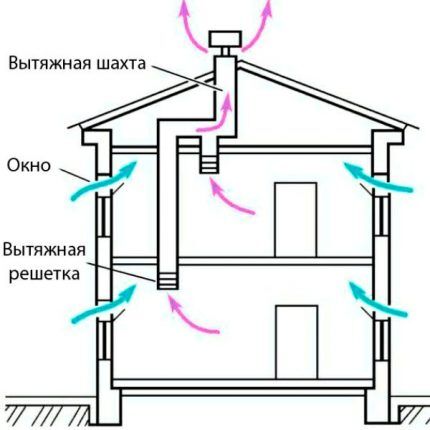
Backdraft into the hood openings occurs due to:
- clogging of ventilation shafts (narrowing their cross-section);
- reducing air flow;
- errors in the design of the ventilation system;
- changes in the design of the ventilation system by adding fans and hoods that were not originally intended.
Normal air exchange occurs only when there is sufficient air flow into the premises of the house. If the windows and doors are sealed, and the supply openings are closed or small, then there will simply be nothing to be drawn out of the rooms. Even at the stage of preparing a ventilation system project, all these nuances are taken into account in order to ensure the proper flow of air masses.
If a few years after the construction of the house a mechanical hood is installed in the kitchen or a gas boiler is installed, then indoor ventilation subject to restructuring. Initially, the channels in it were designed for completely different parameters and volumes of air flow.
In the vast majority of cases, they will be unable to work correctly in conjunction with new elements. Ideally, it will be necessary to completely re-calculate the entire air exchange system.
How can I fix the problem?
To restore proper operation of the ventilation system, you must first identify the root cause of the failure. It’s one thing when there is no normal draft in the ventilation of a private house, and another thing when it constantly tips over (it blows from the exhaust hole back into the room).In each case, the problem will have to be solved differently.
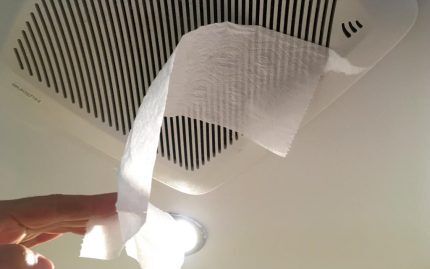
Sometimes there are tips for checking traction using a candle or lighter. It is absolutely forbidden to do this. Dust and grease from cooking on the stove gradually accumulate in the ventilation ducts. Contact of an open flame with this explosive mixture can lead to a fire or pop.
It is safest and most practical to independently determine the draft force in ventilation using plain paper. If you attach a sheet to the exhaust hole, then if the ventilation system is working correctly, it should be pulled towards the grille. If it is pulled back into the room, then the hood in the house is blowing incorrectly - in the opposite direction, which clearly indicates the presence of problems with draft.
Clogged ventilation ducts of a private house
Often in cottages the following situation arises - initially the ventilation worked properly, no changes were made to it and no new devices were installed in the premises that increase oxygen consumption. However, at some point the thrust in the system begins to drop.
The microclimate in the rooms of the house is gradually deteriorating. Moreover, this happens so unnoticeably and slowly that for the time being, none of the family members pay attention to such a problem. But then on the walls mold appears, and the air inside becomes musty.
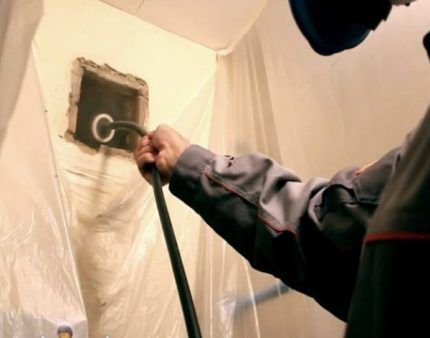
You can clean the ventilation ducts:
- a special metal brush;
- by washing with water;
- industrial vacuum cleaner.
To assess the degree of contamination and the quality of cleaning, you should use a video camera. Only this will allow you to see with your own eyes what is happening inside the ventilation duct.
When cleaning the ventilation, blockages can be found both in the internal sections of the shaft and in its upper section. The top of the ventilation pipe is often clogged with snow, ice or leaves from nearby trees. This happens when there is no deflector or cap.
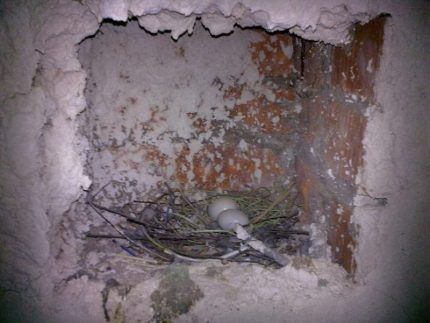
To eliminate all blockages, it is necessary to completely inspect all existing ventilation ducts in the house, from the exhaust vents in the rooms to the outlet on the roof. A narrowing can form anywhere in the system.
If the ventilation pipe does not yet have a protective cap on top, then it must be installed after cleaning. It will reduce the risk of re-clogging and provide increased ventilation draft.
Insufficient air flow
Old houses used to have wooden windows and doors everywhere. Due to their low airtightness, they were constantly draughty, which caused a lot of trouble in winter.
However, these drafts directly participated in air exchange. They provided the necessary air flow. At the same time, the ventilation ducts worked exclusively for exhaust.
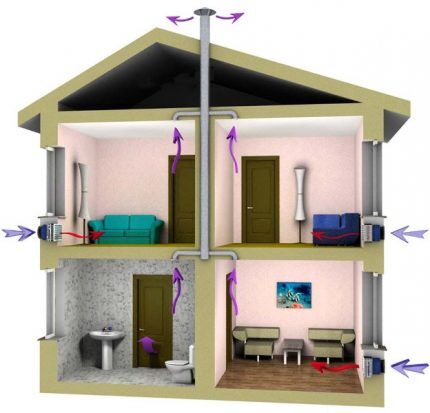
To ensure the proper flow of air masses, the following are installed or arranged:
- window valves;
- supply holes in the walls;
- additional air ducts through the subfloor;
- mechanical fans for organizing forced ventilation.
According to sanitary standards, the air in the living room must be completely replaced with completely fresh air at least once an hour. At the same time, in kitchens and rooms with stoves, boilers or fireplaces, air exchange should be many times higher, since oxygen consumption is greater in them.
Poorly designed ventilation
If the thrust drop occurs from time to time for a couple of hours, then the reason for this usually lies in a banal change in the weather. When calculating the system, the designers did not take something into account, and as a result, during a sudden cold snap, the ventilation in a private house blows inward, rather than pulling out as it should.
This problem can only be solved by completely recalculating the ventilation system.
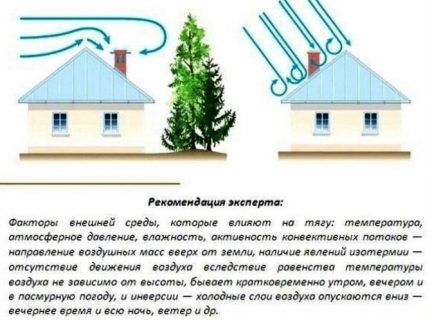
Before ordering a new ventilation project, you should carefully inspect all its components. It is quite possible that dirt has adhered to the ventilation grille or the blades of the duct fan. As a result, the channel has narrowed quite a bit - most of the time the system works properly, but occasionally it crashes. In this case, simply cleaning is enough.
A new tall building next to the cottage, a change in the geometry of the roof, the installation of a satellite dish - all this can lead to a decrease in traction. If obstacles appear in the path of the wind, then in the area of the top of the ventilation pipe the initial air pressure parameters change. And then the speed of its movement through the ventilation ducts drops.
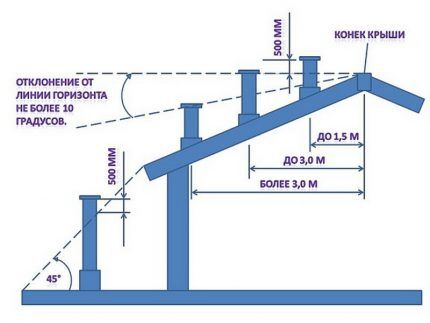
To increase draft in the ventilation shaft, a deflector should be installed on top. It creates a slight vacuum around itself, causing air from the house to rush into this void.
Deflectors are most effective in windy weather. If the street is calm, then such a device will be of no use. In such a situation, it is possible to increase traction only with the help of mechanical stimulation - a fan.
And the last point - in order to prevent the draft from tipping over, the ventilation grilles on the hood in the rooms should be changed to check valves. When there is a flow of air from the ventilation into the room, they close, blocking the hole.
Conclusions and useful video on the topic
All the nuances of draft formation in home ventilation:
Why does reverse draft occur in ventilation ducts:
The formation of reverse draft in ventilation occurs rarely. This is a serious and unpleasant problem, but finding and eliminating the cause yourself is not so difficult. You just need to carefully examine the entire ventilation system existing in the cottage, and, if necessary, clean or slightly modify it.
If you have had a situation where the hood in your house suddenly began to blow in the opposite direction, then share your method of solving this problem. You can also ask a question about the topic discussed in the article, and our experts will definitely help you understand all the nuances of ventilation.



